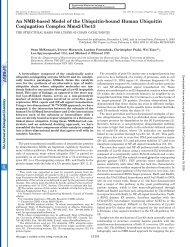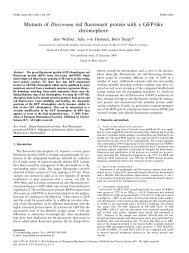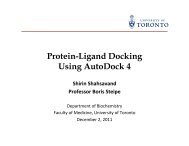Tumor Initiating Cells, Cell Cycle Control and Cancer Stem Cells
Tumor Initiating Cells, Cell Cycle Control and Cancer Stem Cells
Tumor Initiating Cells, Cell Cycle Control and Cancer Stem Cells
You also want an ePaper? Increase the reach of your titles
YUMPU automatically turns print PDFs into web optimized ePapers that Google loves.
Summary<br />
1. D type cyclins respond to extra cellular signals to induce Rb phosphorylation<br />
<strong>and</strong> transition through the R point.<br />
2. Other cyclins (E, A, B) act autonomously to drive S phase <strong>and</strong> mitosis.<br />
3. CDK inhibitors p21 <strong>and</strong> p27 are required to assemble D-CDK4/6 <strong>and</strong> inhibit cyclins E, A<br />
<strong>and</strong> B-CDK complexes.<br />
4. As D cyclins become elevated they phosphorylate pRb (catalytic) <strong>and</strong> also sequester p21/p27<br />
(non-catalytic), thereby allowing E-CDK2 to further phosphorylate <strong>and</strong> inactivate pRb.<br />
5. Cyclin D1 also act as a transcriptional co-factor to induce or suppress transcription of various<br />
genes such as Notch1 during retinal development (non-Catalytic),<br />
6. Cyclin A <strong>and</strong> B maintain hyper-phosphorylated ppRb through S <strong>and</strong> G2/M. At mid-mitosis<br />
pRb is dephosphorylated by type 1 phosphatase.<br />
7. The pathways that regulate CDKI, the cyclins <strong>and</strong> associated kinases are often<br />
deregulated in human cancer.<br />
8. Rb-E2F suppress both cell cycle genes (cyclin E, Thymidylate synthase, Cdk1) as well<br />
as pro-apoptotic genes such as caspases, Puma, <strong>and</strong> Noxa. The effect of pRb-E2F<br />
deregulation (cell proliferation vs apoptosis) is context dependent.







